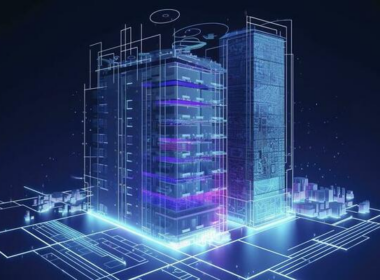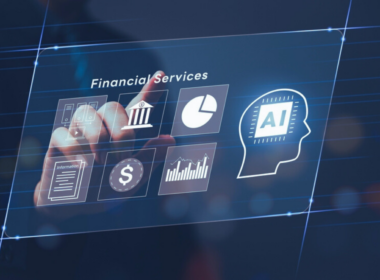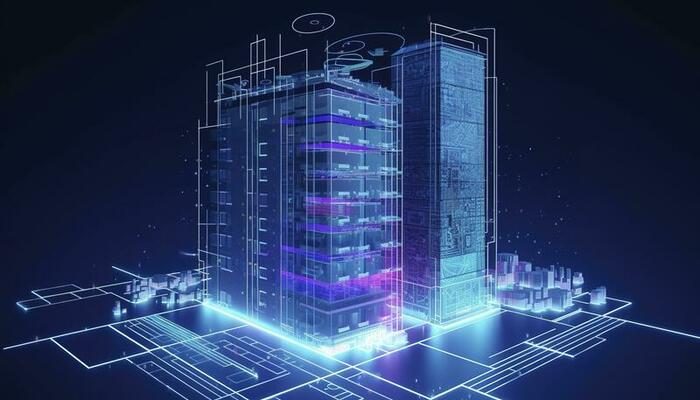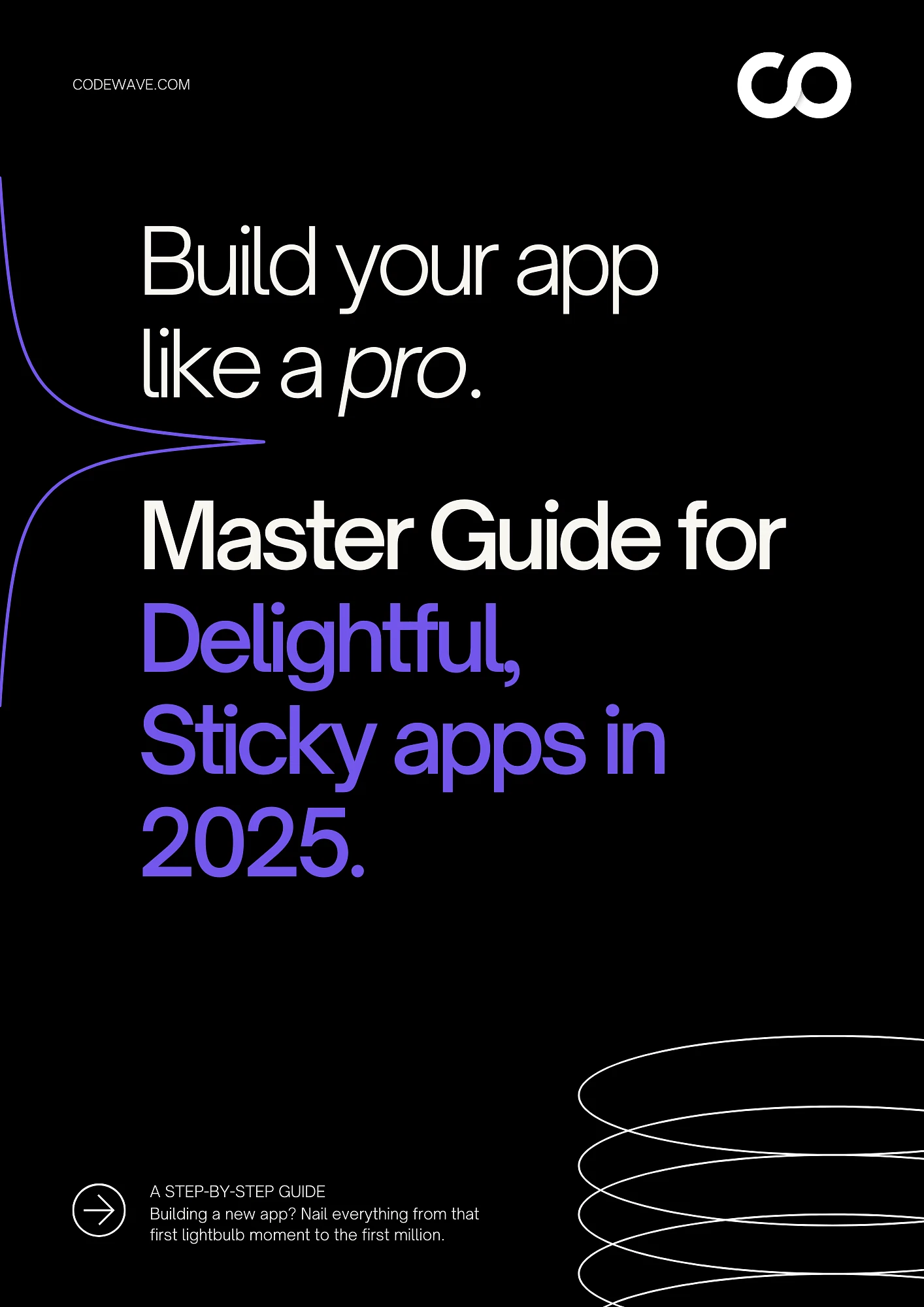What if Your Enterprise Could Have Its Own AI?
Private, proprietary, and perfectly aligned with your way of working?
Today, teams increasingly rely on GenAI, but enterprises pay high subscription costs for hundreds of public LLM licenses, often just for basic content generation tasks. Even after all that investment, you lack full control over AI models, limiting their ability to adapt to your workflows. On top of that, data privacy and compliance challenges remain a constant concern.
Imagine an AI alternative to public LLMs and Agents. One that gives you:
Privacy & Security — A cost-efficient, fully private alternative to public LLMs.
Flexibility & Scale — Built around your systems for full control, minus the waste.
Speed & Efficiency — Accelerates research, analysis, content creation, and workflow automation.
Your Enterprise Touch — Delivers persona-driven insights infused with your team’s unique expertise.
Most public models and off the shelf AI tools overpromise and underdeliver. 85% of AI projects fail to deliver value simply because they can’t integrate with existing enterprise systems — and 37% of businesses struggle with data integration. Generic GenAI tools might automate tasks, but without a real-time connection to your operations and workflows, they can create more bottlenecks than breakthroughs.
A custom AI solution architecture solves this. Purpose-built for enterprise-grade integration, it connects seamlessly with your systems, adapts to your proprietary data, and automates mission-critical workflows with precision— driving faster decisions, reduced manual work, and optimized operations, ultimately saving time, cutting costs, and boosting your bottom line.
Why you need a smarter alternative to Public LLMs
- Off-the-shelf solutions often fail to scale, leaving businesses grappling with high costs, security issues, and data integration problems that hinder growth.
- Custom-built AI agents integrate directly with your systems, automate workflows, and use real-time data to make informed decisions, significantly improving performance.
- These agents continuously learn and adapt, becoming smarter over time to solve specific business challenges with precision, making them a valuable long-term asset.
- With layered architecture from data collection to decision-making and action, our solutions ensure smooth workflows and real-time responsiveness.
- By automating routine tasks, improving decision-making, and ensuring compliance, custom AI agents free up resources and drive efficiency, supporting sustainable growth and scalability.
What Does It Take To Set Up A Custom AI Agent Workforce?
Agentic AI systems and solution architectures are designed to drive business agility by building intelligent systems that self-learn, adapt, decide, and execute in real time.
For enterprises, this means no more spending big on monthly subscriptions to public LLMs and struggling with a lack of control. Instead, you get to build a proprietary AI workforce with full control over the models, access to data, systems, and workflows leading to accelerating decision-making, and eliminating manual, error-prone processes. The result is scalable operations, predictable costs, and a compounding knowledge asset that strengthens your competitive moat.
What Can An Augmented AI Workforce Do To Your Operations?
AI-Powered Document Intelligence
A custom AI agent that searches, summarizes, tags, and drafts reports, proposals, and client deliverables — turning hours of manual work into minutes.
Automated Workflow & Process Optimization
AI-driven automation for due diligence, contract review, resume screening, and other repetitive tasks — reducing costs and speeding up decision-making.
Predictive Analytics & Strategic Insights
An AI workforce that continuously benchmarks competitors, forecasts trends, and integrates internal and public data to deliver actionable, foresight-driven recommendations.
Persona-Driven Productivity Tools
Custom AI that delivers insights, onboarding assistance, survey analysis, and content tailored to each team member’s role — improving efficiency and knowledge accessibility across the enterprise.
Client & Brand Communication Automation
AI agents that generate newsletters, updates, and reports — ensuring timely, consistent, and personalized communication for clients and internal teams.
And more.
In essence: a custom AI workforce that automates, optimizes, and augments operations — making your enterprise faster, smarter, and more efficient.
Here’s how it works behind the scenes:
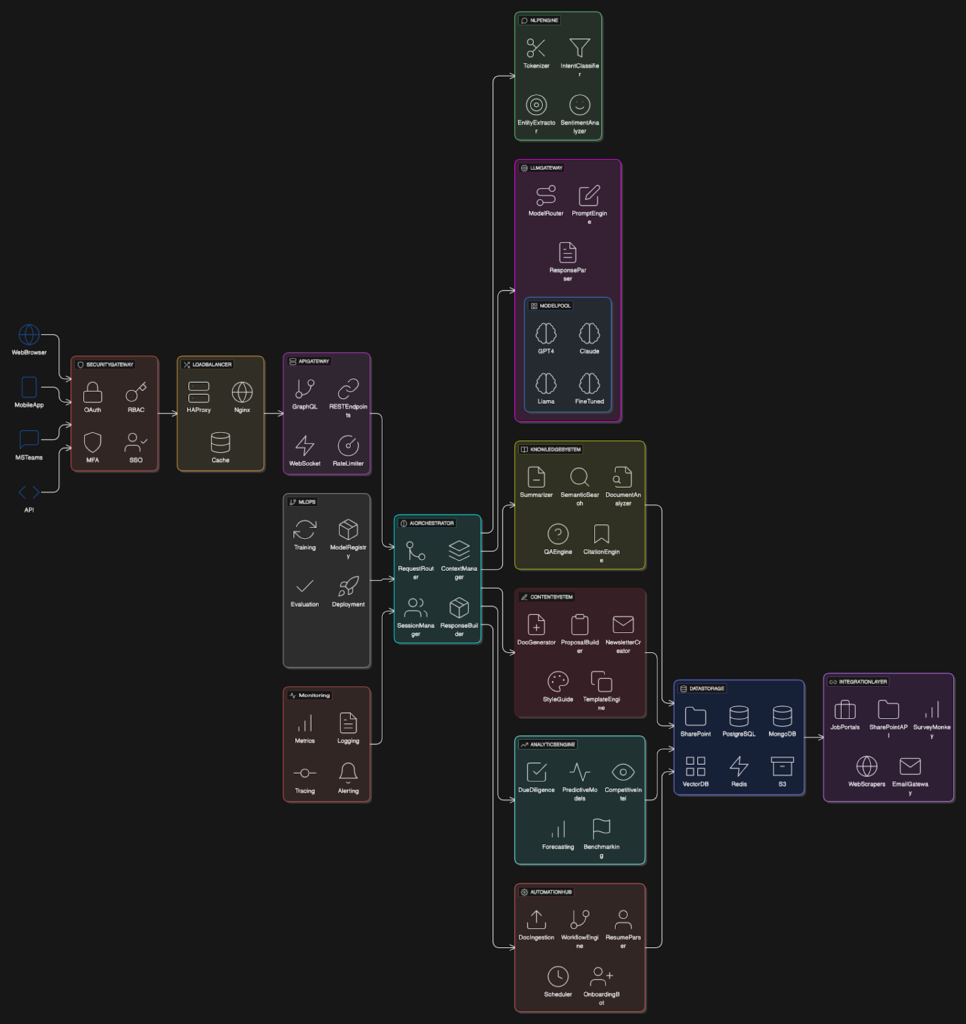
- Perception Layer: The agent gathers data in real time, pulling it from APIs, databases, and other systems. It’s designed to act immediately on the data that’s most relevant at any given moment. For example, in a supply chain, the agent pulls in live data on inventory levels, shipments, and order status to make decisions on the fly.
- Reasoning Engine: The core of the agent, where real decisions happen. It uses business-specific models to turn raw data into clear, actionable insights. Whether it’s predicting future demand or optimizing routes for deliveries, this engine processes the most relevant variables to arrive at precise conclusions, every time.
- Action Interface: This is where decisions translate into real action. The agent doesn’t just flag issues; they take the next step. For example, if the agent detects that stock levels are running low, it automatically places an order to replenish or triggers a notification for the team to step in. It doesn’t just make suggestions; it drives action, reducing the time between insight and outcome.
- Memory and Learning Systems: AI agents get better with time. They track decisions and evaluate results to adjust their logic. Over time, this improves their accuracy and decision-making speed. Think of it like an employee who keeps getting better at their job through experience. The more data it interacts with, the more it refines its actions to get faster, more accurate results.
- Security and Compliance Protocols: Every business operates under a set of regulations. AI agents are built to follow them. Whether it’s protecting customer data or meeting financial reporting requirements, this layer ensures the agent operates within the boundaries of security standards and legal frameworks like GDPR or SOX.
Why Generic AI Tools Fall Short for Enterprises
Generic AI tools may seem like a quick fix, but they’re often ill-equipped for the high-end needs of enterprises:
- Cost Scaling: Generic AI tools often follow a pay-per-use model, which means costs can explode as your usage increases. Scaling comes at a steep price, with little transparency in how these costs will grow with your business.
- Lack of Control & Customization: These tools are designed to fit a wide range of businesses, but your company’s needs are different. They often fail to adapt to specific requirements, leaving tasks half-automated or incorrectly executed.
- Data Privacy & Leakage Risks: Using third-party AI tools to process sensitive data opens the door to security risks. Data stored and processed externally increases the likelihood of breaches, which could expose proprietary information and customer data.
- Generic Outputs with No Proprietary Insight: These tools generate general recommendations that lack the specificity required for real decision-making. For example, a marketing AI tool might suggest broad strategies but fail to analyze your specific customer data, leading to suboptimal results.
- Vendor/SaaS Lock-In: Relying on off-the-shelf AI tools means you’re at the mercy of the vendor’s roadmap and pricing. Any changes or updates outside of your control can disrupt your workflows and force you to adapt to a system that may no longer meet your needs.
So, how does a custom solution solve the real problems you’re facing? Let’s dive deeper into why off-the-shelf solutions fall short.
The Value Proposition of a Custom, Knowledge-Powered AI Agent
Custom, knowledge-powered AI agents are built to work specifically for your business, using internal data to make smarter decisions. Unlike one-size-fits-all solutions, these agents provide real-time insights and adapt as your business evolves, driving efficiency and innovation.
Embedding Proprietary Knowledge into AI Agents
A custom AI agent doesn’t follow generic rules. It works within the context of your operations. Instead of just processing data, it taps into your internal resources, such as past projects and employee knowledge, to make decisions based on real-world insights.
For example, in project management, the agent can pull data from past project outcomes, current resources, and client-specific needs. It uses this to recommend the best workflows and timelines, adjusting based on both your historical data and real-time conditions.
This leads to improved project delivery, lower overheads, and better overall operational performance, all based on decisions rooted in your business knowledge.
Better Decision-Making with Real-Time Business Context
Effective decision-making requires relevant data at the right time. Generic AI tools often fall short because they lack the depth required for complex decisions. A custom-built agent integrates your systems and past performance data, analyzing the business context to provide timely, targeted decisions.
For example, in demand forecasting, an agent considers sales trends, customer behavior, and market conditions. It doesn’t just predict fluctuations; it provides actionable insights on resource allocation.
This results in better alignment with business goals, more accurate predictions, and faster market adaptation, all driven by real-time data.
Automating Routine Tasks to Free Up Human Resources
Many enterprises waste time on low-value tasks. With a custom AI agent, your teams can focus on strategic initiatives while the agent handles routine tasks like data entry, reporting, and customer queries.
In a sales environment, for instance, the AI can automate lead scoring. This reduces the manual effort spent on vetting leads and allows your sales team to concentrate on high-priority opportunities.
This leads to lower operational costs, higher employee productivity, and faster response times, all through automation.
Protecting Data and Meeting Regulatory Demands
A custom AI agent is built with security and compliance as core principles. It ensures your systems meet industry regulations without sacrificing performance. Instead of trying to fit into generic compliance models, the agent is tailored to follow specific requirements for your industry, such as GDPR, SOX, or HIPAA.
For example, a financial institution using a custom agent can apply real-time encryption to protect customer data and automate financial reporting to stay audit-ready.
This results in stronger data security, reduced legal risks, and greater trust from your clients.
Scaling with Your Business, Not Against It
As your business evolves, so must your systems. Generic AI often struggles to keep up with new markets, data sources, or regulatory requirements. A custom AI agent is designed to scale with your business, adapting to changes without disruption.
For instance, when expanding into new regions, the agent can easily integrate local regulations, new market data, and specific business strategies without needing a complete overhaul.
This offers flexible scalability, continuous support, and custom solutions that evolve alongside your operations.
Layered Architecture for Enterprise Agents
A layered architecture is the backbone of an AI system. It’s designed to ensure performance and scalability, enabling different components such as data processing, security, and integration to work smoothly together. Think of it as the foundation that supports your AI’s growth and effectiveness over time.
1. Frontend / API / UI Layer
The frontend layer enables users to interact with the system by submitting requests and viewing responses.
- It provides a user interface for easy access to agent functions.
- Tools like React.js and GraphQL ensure smooth integration, making it easy for users to interact with the system and adopt it quickly.
2. Authentication & Security / Access Control
Protecting sensitive business data is essential. This layer controls access and ensures data stays secure.
- It uses OAuth 2.0 and AWS IAM to grant access only to authorized users.
- This ensures that your data is protected and your system complies with regulations like GDPR and SOX.
3. API Gateway / Orchestration / Routing
The API gateway directs requests to the right services, managing data flow efficiently.
- Kong manages API requests, while Apache Kafka handles real-time data streaming.
- Efficient routing ensures that data reaches the right part of the system without delays, keeping everything running smoothly even under heavy workloads.
4. Agent Orchestrator
The orchestrator coordinates multiple agents to ensure they work together effectively.
- It controls task execution, ensuring that agents interact smoothly and perform their work without conflict.
- It optimizes workflows, ensuring that agents collaborate efficiently to achieve business goals.
5. Model Pool (Base + Fine-Tuned Models)
This component handles the task of selecting the right model for the job.
- It uses base models for general tasks and fine-tuned models for specific business needs.
- By using the right model for each task, the system remains efficient, delivering accurate results without unnecessary complexity.
6. Document & Knowledge Processing
This layer processes unstructured data, making it useful for decision-making.
- It extracts information from documents using tools like Apache Tika and spaCy, tagging and structuring the content.
- It converts raw data into actionable insights, eliminating the need for manual processing and improving decision accuracy.
7. Backend Integrations & Workflow Engine
To be effective, the AI agent must work with your existing enterprise tools. This layer ensures smooth integration with your CRM, ERP, and other systems.
- It integrates with systems like Salesforce, SharePoint, and Jira, automating workflows across platforms.
- It reduces manual intervention by automating repetitive tasks, improving workflow and data flow across systems.
8. Execution, Automation, Logging, Monitoring
This layer monitors system performance, automates tasks, and ensures smooth execution of operations.
- It tracks performance with Prometheus, logs activities with Elasticsearch, and monitors the system in real time.
- Continuous monitoring helps detect issues early, maintaining high service reliability and performance.
9. Storage (Structured & Unstructured Data)
Effective storage of both structured and unstructured data is essential for decision-making.
- It stores structured data in PostgreSQL and unstructured data in Amazon S3, providing flexibility in data handling.
- This ensures the agent can access and process all types of data, making well-informed decisions based on a complete view of your business.
10. Model Training, Evaluation & Deployment Pipeline
AI models must be continuously improved to remain effective.
- It uses Kubeflow for model training and Kubernetes for scalable deployment.
- Continuous training ensures the models adapt to new data, improving over time to meet evolving business needs.
When choosing an AI solution, you need to weigh the strengths of a custom-built solution against an off-the-shelf platform. Let’s compare these options to help you decide which one is the best for enterprise-grade solutions.
Comparison: Custom AI Solutions vs. Microsoft Copilot vs. Azure AI
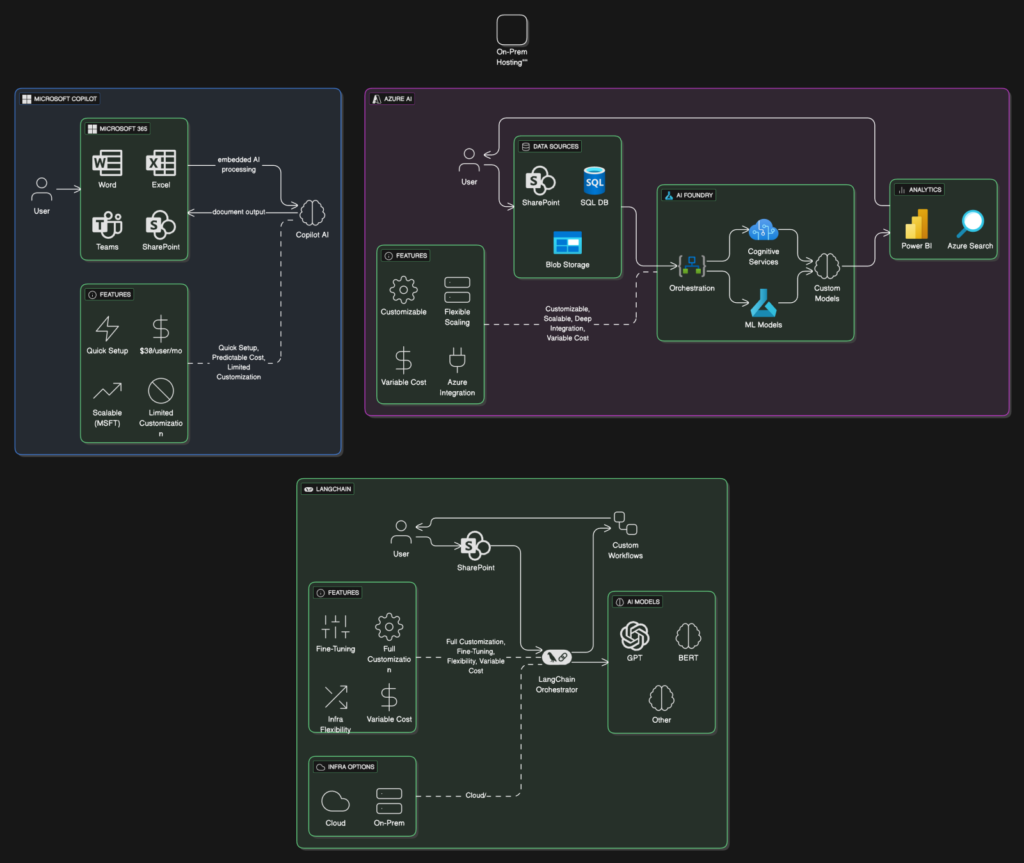
Choosing between custom-built AI and third-party solutions like Microsoft Copilot or Azure AI is a big decision. Each has its strengths, but understanding the trade-offs in control, cost, and scalability will help you make the best choice based on your industry specifications and long-term goals.
| Criteria | Microsoft Copilot | Custom Architecture | Azure AI using LangChain |
| Control | Limited control over models; pre-built for general tasks | Full control over model selection, customization, and fine-tuning | Full control with dynamic model selection, orchestration via LangChain |
| Dynamism | Fixed models (e.g., GPT, proprietary models) for predefined tasks | Custom-built models tailored to specific tasks, allowing task-specific optimizations | LangChain allows dynamic orchestration, switching models based on task for optimized performance |
| Efficiency | Optimized for common tasks like summarization, scheduling, etc., but lacks flexibility | Full pipeline optimization, custom fine-tuning, prompt engineering to improve efficiency | Fine-tuning models based on tasks, optimized for real-time performance and data handling |
| Scalability | Scales within Microsoft’s cloud ecosystem, but limited for specialized needs | Flexible scaling based on custom infrastructure (cloud, on-prem) | Scalable through Azure cloud, dynamically adjusting resources based on demand |
| Cost | Subscription-based; higher recurring costs based on users and features | Higher initial cost, but low long-term costs as there are no subscription fees | Flexible cost structure based on usage; optimized resource allocation through Azure infrastructure |
| Integration | Integrates seamlessly with Microsoft tools (e.g., Word, Excel, Outlook) | Integrates with any enterprise tools (CRM, ERP, databases) for full customization | Integrates with Azure ecosystem and external tools, allowing seamless workflows across platforms |
| Customization | Limited ability to customize model behavior for specific tasks | High customization for business-specific tasks and models | Fine-tuning models via Azure ML for task-specific performance and adjustments |
| Security | Built on Microsoft’s secure infrastructure, with enterprise-grade security protocols | Security is designed to fit enterprise needs, from data encryption to compliance (e.g., GDPR, HIPAA) | Azure AI provides high security with encryption and compliance features like GDPR, HIPAA, and more |
| Data Privacy | Data is processed through Microsoft’s cloud, with some concerns over data privacy in third-party tools | Data stays within the enterprise, ensuring control over sensitive business data | Data privacy is managed through Azure’s secure environment, ensuring compliance and control over data access |
Now that we’ve explored the capabilities, let’s take a closer look at how the cost structures compare, helping you choose the most efficient option for your business
Cost Comparison
| Aspect | Microsoft Copilot | Azure AI using LangChain | Custom AI Solutions |
| Initial Investment | Low (Subscription-based pricing) | Moderate (Pay-as-you-go for compute, models) | High (Custom development, infrastructure) |
| Ongoing Costs | Subscription-based fees | Variable (Cloud resources, compute costs) | High (Maintenance, scaling, data management) |
| Scalability | High (Cloud-based) | High (Flexible scaling with Azure) | High (Scalable with custom infrastructure) |
| Customization | Limited (Pre-built features) | High (Dynamic model orchestration) | Extensive (Fully tailored to business needs) |
| Integration | Easy (Microsoft 365 apps integration) | Flexible (Custom integrations via Azure) | Full (Custom integration with internal systems) |
| Security & Compliance | Standard (Microsoft security protocols) | High (Azure security, compliance standards) | High (Custom security and compliance) |
Why Azure AI Using LangChain Development Is More Expensive
The investment is higher because you’re getting a system designed to evolve with your business, one that adapts, scales, and optimizes for real results. Let’s break down why it’s worth the cost.
- Model Orchestration and Customization: LangChain requires orchestrating multiple models for specific tasks. This level of customization demands expertise in AI system design, driving up initial development costs. Custom solutions are tailored to specific requirements, but configuring them takes significant time and resources.
- Scalable Infrastructure: Azure’s cloud infrastructure requires high-performance GPUs and storage solutions to handle large datasets and real-time tasks, increasing scalability costs. As your business grows, scaling your AI systems becomes more expensive, especially with high-capacity compute needs.
- Advanced Data Processing: Real-time data processing involves building strong pipelines to structure and clean data for LangChain models. Specialized teams are required for data handling, which adds setup and maintenance costs to ensure efficient data flow.
- Security and Compliance: Implementing security measures like GDPR and HIPAA compliance requires dedicated resources to meet legal and ethical standards. Continuous monitoring and adjustments add to development costs, but they ensure long-term data protection.
- Long-Term Maintenance and Optimization: LangChain-powered systems need ongoing updates, model retraining, and fine-tuning to stay effective. Maintenance costs ensure your AI solution remains aligned with evolving business needs and performs consistently over time.
How Codewave Designs High-Impact Custom AI Agents (LLMs, ChatGPT)
At Codewave, we don’t just build AI agents; we engineer systems that embed directly into your business DNA. Our approach ensures that your AI doesn’t just “work”, it drives performance, scales with ease, and continuously adapts to the ever-evolving landscape of your operations.
Our Process for Building AI Agents:
- Vision Alignment: We kick off by syncing with your leadership and key stakeholders to lock down critical business objectives. No fluff, just a clear, aligned vision from day one.
- Release Planning: Focus is everything. We prioritize features that align with your strategic goals and ensure the team is aligned on a timeline that respects your business rhythm.
- Backlog Refinement: Every two weeks, we fine-tune what’s essential, adapting to your shifting priorities so we’re always focusing on high-impact tasks.
- Sprint Execution: We keep things agile. With bi-weekly sprint cycles, we guarantee the team is delivering measurable results—on time and on target.
- Testing & Delivery: Rigorous testing happens throughout development to ensure that the AI not only meets your needs but also performs at scale.
Why Choose Codewave?
- Performance-Oriented Design: Your AI agent isn’t an off-the-shelf solution. It’s engineered with your business’s core operations in mind, driving outcomes, not just insights.
- System Integration Mastery: We make your entire ecosystem smarter by ensuring that data flows naturally across platforms, unlocking potential in real-time.
- Adaptive, Self-Learning Agents: Our agents evolve. They don’t just act on today’s data; they learn from every interaction, making them sharper, faster, and more aligned with your long-term vision.
- Scalable Solutions That Grow With You: Whether you’re expanding into new markets or handling increased data loads, our agents scale effortlessly, adapting without disruption to meet your new business challenges.
- Security-Centric Development: Security isn’t an afterthought. We build compliance into every layer of the AI’s architecture, ensuring it meets the highest standards, whether it’s HIPAA, GDPR, or industry-specific regulations.
Stop settling for AI that works for “any” business. Codewave’s custom AI agents are designed to work for your industry, at the enterprise level, solving real-world problems and unlocking growth potential. Contact us Today!
FAQs
What are the key differences between generic AI tools and custom-built AI agents?
Generic AI tools are designed to fit a broad range of businesses, but they often fail to meet the specific requirements of larger enterprises, resulting in poor performance, high costs, and security risks. Custom-built AI agents are tailored to solve unique business problems and seamlessly integrate with existing systems.
How do custom AI agents improve decision-making in enterprises?
Custom AI agents analyze real-time data, adapt to evolving conditions, and provide actionable insights that are context-specific, enabling better, faster decision-making with fewer errors.
Why are generic AI tools unsuitable for enterprise-scale operations?
They often come with scalability issues, lack the ability to integrate deeply with complex systems, and pose security and privacy risks—especially when handling sensitive data.
How can custom AI agents scale with my business as it grows?
Custom AI agents are designed with scalability in mind, allowing them to adapt to new markets, larger data sets, and evolving regulations without requiring a complete overhaul of your infrastructure.
What industries can benefit from custom AI agents?
Industries like healthcare, finance, manufacturing, and retail can greatly benefit from custom AI agents to streamline operations, optimize decision-making, and ensure compliance with industry regulations.
Codewave is a UX first design thinking & digital transformation services company, designing & engineering innovative mobile apps, cloud, & edge solutions.
